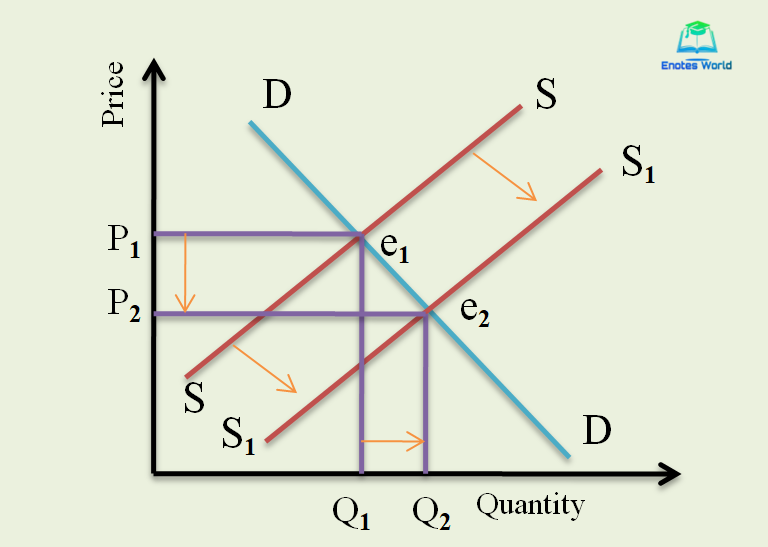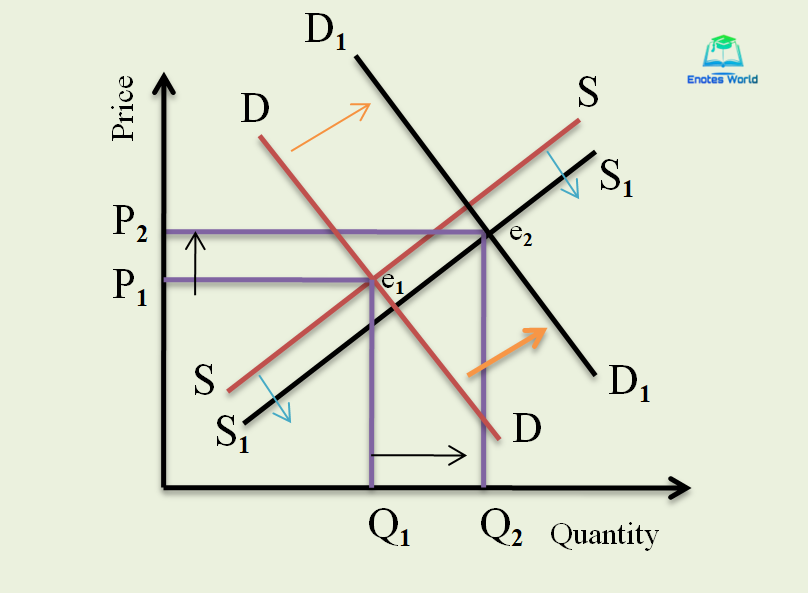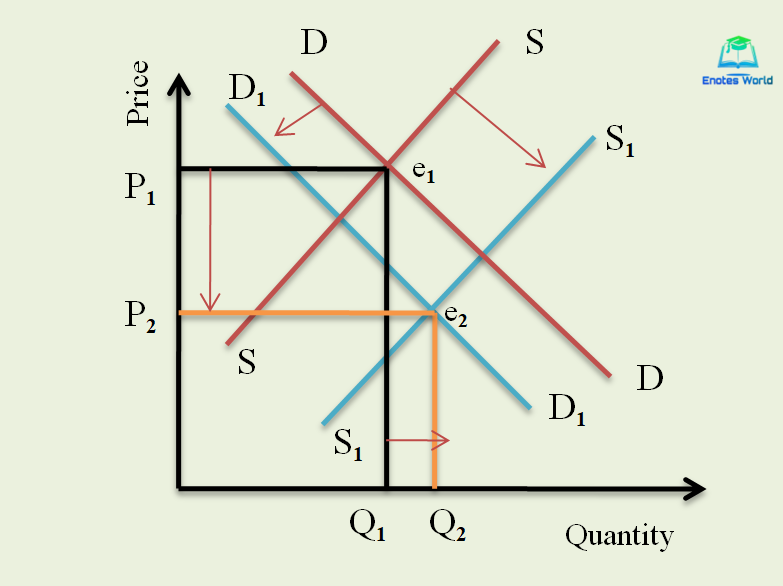Market equilibrium implies a certain type of stability in both the price and quantity of goods. But changing market forces may disturb the equilibrium, either by shifting demand, shifting supply, or shifting both demand and supply. Over time the equilibrium point changes its position. Any factors that cause a change in demand shifts the demand curve towards left or right and the initial equilibrium point changes its position. Similarly, any increase or decrease in supply also brings changes to the equilibrium points. Thus there is a deep relationship between demand, supply, and their effect on market equilibrium.
When a consumer’s income increases, the number of consumers increases, taste and preferences of consumers go in favor of a good or services, demand for a product increases, and the demand curve shifts to the right. Conversely, the demand curve shifts to the left and there is a decrease in demand due to a decrease in the income of consumers, consumers start disliking a particular product, and so on. The shift in demand and supply thus changes market equilibrium means demand and supply have an effect on market equilibrium. It may happen due to simultaneous changes in both demand and supply. All cases of change in equilibrium can be briefly explained below.
Contents
Effect of Change in Demand Only
Case-I: When market demand increases with market supply being constant
If the supply remains constant, the shift of the demand curve, i.e., a change in demand will result in a change in equilibrium price and equilibrium quantity. An increase in income of the buyers and an increase in population shift the demand curve to the right representing an increase in demand. In such a situation, there will be a rise in price and quantity at the new equilibrium point. The following diagram shows the overall effect of the increase in demand on market equilibrium;

In the above figure, the initial equilibrium is e1 with the interaction of the initial demand curve DD and supply curve SS. At this point, the equilibrium price is OP1 and the quantity is OQ1. If there is an increase in demand represented by a rightward shift in the demand curve from DD to D1D1 the new equilibrium point e2 establishes. With the new equilibrium, price increases from P1 to P2, and quantity also increases from OQ1 to OQ2. Therefore, when there is an increase in demand assuming supply remains constant, the price and quantity both increase.
Case-II: When market demand decreases with market supply remains constant
When there is a decrease in income of the consumers, any inverse effect of taste and preference, falls in the size of the population and due to natural causes then there may be a reduction in the demand for a commodity. This results in a leftward shift in the demand curve or a decrease in demand. In such a situation, the equilibrium price of the commodity as well as equilibrium quantity will decrease at a new equilibrium point. This is shown in the given diagram;

In the above figure, e1 is the initial equilibrium as an interaction of initial demand and supply curve DD and SS respectively. The initial equilibrium price is OP1 and the quantity is OQ1. When there is a decrease in demand for the product represented by the leftward shift in the demand curve from DD to D1D1 the new equilibrium point e2 establishes. At the new equilibrium, the price and quantity are OP2 and OQ2 respectively. Thus, we can conclude from the diagram that the decrease in demand while supply remains constant will reduce both equilibrium price and quantity in the market.
Effect of Change in Supply Only
Case-III: When market supply increases with market demand being constant
If there is an increase in the number of suppliers, a decrease in the price of related goods, a decrease in the price of factor inputs, a decrease in government taxation, and an increase in production subsidies, the supply will increase. This brings a rightward shift in the supply curve. And in such a situation there will be a fall in price and a rise in quantity at a new equilibrium point. The following graph shows the overall effect of an increase in market supply with constant demand.

In the above figure, e1 is the initial equilibrium obtained by the interaction between DD and SS demand and supply curves. At the initial equilibrium point, the equilibrium price is OP1 and the quantity is OQ1. When there is an increase in the supply represented by the rightward shift in the supply curve from SS to S1S1 the new equilibrium point e2 is established with a new reduced equilibrium price and increased quantity OP2 and OQ2 respectively. Thus the increase in supply while demand remains constant will reduce equilibrium price and boost quantity in the market.
Case-IV: When market supply decreases with market demand being constant
When there is a decrease in the number of suppliers, an increase in the price of related goods, an increase in the price of factor inputs, an increase in government taxation, and a decrease in production subsidies, the supply will decrease. This brings a leftward shift in the supply curve, an increase in price, and a decrease in equilibrium quantity in the market. The overall effect has shown with the help of the following diagram;

In the figure, the initial equilibrium has been obtained at the interaction of DD and SS at point e1 with the equilibrium price OP1 and quantity OQ1. The decrease in supply is represented by the leftward shift in the supply curve from SS to S1S1 and as a result, there is the establishment of a new equilibrium point e2. A new equilibrium point is characterized by an increase in equilibrium price (OP2) and a decrease in equilibrium quantity (OQ2). Therefore, when there is a decrease in supply keeping demand constant will up the equilibrium price and down the equilibrium quantity of demand and supply.
Effect of Simultaneous Changes in Demand and Supply Both
When there is a change in demand and supply then the prediction of changes in price and quantity becomes a little complicated. The relative magnitude of change in supply and demand determines the effect in equilibrium price and quantity of demand and supply. Thus the following section shows changes in demand and supply simultaneously and their effect on market equilibrium.
Case-V: When market demand and market supply both increase with the increase in demand greater than the increase in supply
This is the case of an increase in both demand and supply but the magnitude of the increase in demand is greater than that of supply. Such changes will represent the rightward shift in both the demand and supply curve. The ultimate measurement or ultimate effect is determined by the change of a larger magnitude. In this case, the magnitude of the increase in demand is higher than the magnitude of change/increase in supply. Thus increase in demand will have the ultimate effect on equilibrium price and quantities. So there will be a rise in price and quantity at the new equilibrium point. The overall effect can present with the help of the following diagram.

In the above diagram, the initial demand and supply curve DD and SS intersect with each other at point e1. This is the initial equilibrium point with equilibrium price OP1 and quantity OQ1. Suppose there is an increase in demand and supply both as represented by a rightward shift in both demand and supply curve to D1D1 and S1S1 respectively.
But in such a case, we assume that an increase in demand is greater than supply and this is represented by a higher gap between DD to D1D1 than the gap between SS and S1S1. New shifted demand and supply curves intersect each other at point e2-new equilibrium point. At the new equilibrium point e2, there is an increase in equilibrium price and quantity as OP2 and OQ2. Therefore in the case of a simultaneous increase in demand and supply, the larger magnitude of change will have an ultimate effect on the equilibrium establishment and adjustment process.
Case-VI: When market demand and supply both increase with the increase in a supply greater than the increase in demand
In this case, we have a higher increase in supply than an increase in demand. Thus ultimately price will decrease and quantity will increase at the new equilibrium of the market. The overall effect has explained with the help of the following diagram.

In the diagram, e1 is the initial equilibrium as the interaction between DD and SS. The initial equilibrium price is OP1 and the quantity is OQ1. Suppose there is an increase in both demand and supply both and thus there rightward shift in the demand and supply curve as D1D1 and S1S1. The increase in supply is higher than that of demand thus the distance between SS and S1S1 is higher than the distance between DD and D1D1. So the ultimate effect has been determined by the larger magnitude of increase in supply and that will reduce the price and increase the quantity at the new equilibrium point-interaction of D1D1 and S1S1.
Case-VII: When market demand increases and market supply decreases with an increase in demand greater than the decrease in supply
Here in this case market demand is increased and it will shift the initial demand curve right from its original position. And supply is decreased and it will shift the market supply towards the left from its original position. We assume that the increase in demand is greater in value so the ultimate effect is determined by such. Thus a new equilibrium point the price as well as quantity both will be increased. The following diagram shows the overall effect of the case.

In the figure, the initial equilibrium is e1, where initial demand and supply DD and SS intersect with each other. At such point, the initial price and quantity are OP1 and OQ1 respectively. Suppose there is an increase in demand and a decrease in supply so demand shifts rightward from DD to D1D1 and supply shifts leftward from SS to S1S1. New demand and supply curves D1D1 and S1S1 intersect with each other at point e2- the new equilibrium point. At the newly established equilibrium point, there is an increase in equilibrium price and quantity as OP2 and OQ2 respectively. It is due to a higher magnitude of the increase in market demand than the magnitude of the decrease in market supply.
Case-VIII: When market demand increases and market supply decreases with a decrease in supply is greater than the increase in demand
Here in this case market demand is increased, market supply is decreased and the magnitude of the decrease in supply is greater than that of an increase in demand. Thus the ultimate effect is based on a decrease in market supply and this will be a rise in price and a fall in quantity at the new equilibrium point. The overall effect has presented with the help of the following diagram.

In the above figure, the DD and SS curve form the equilibrium e1 with equilibrium price OP1 and quantity OQ1 respectively. Suppose there is an increase in demand and decrease in supply as represented by D1D1and S1S1 respectively. Their interaction forms a new equilibrium point e2. At the new equilibrium point, the new equilibrium price is OP2 which is higher than the previous equilibrium price and the quantity is OQ2 and which is lower than the previous equilibrium quantity. This is due to a higher magnitude of decrease in supply than the increase in demand.
Case-IX: When market demand decreases and market supply increases with an increase in a supply greater than the decrease in demand
In the situation of a decrease in demand and market supply increase with an increase in supply is greater there will be a fall in price and increase in quantity at a new equilibrium point. The following figure shows the overall effect of case-IX.

In the figure, e1 is the initial equilibrium with equilibrium price OP1 and quantity OQ1. Suppose there is a decrease in demand and as a result, the initial demand curve shifts leftward to D1D1 and an increase in supply, and as a result, the original supply curve shifts rightward to S1S1. These both intersect with each other at point e2-the new equilibrium point. At the new equilibrium point, the new equilibrium price is OP2 which is less than the old equilibrium price and the new equilibrium quantity is OQ2 which is higher than the old one. This is due to a higher magnitude of increase in supply than the magnitude of the increase in demand.
Case-X: When market demand decreases and supply increases with a decrease in demand greater than the increase in supply
In the case of a decrease in the market, demand is greater than an increase in supply the price will fall and quantity will be decreased due to a higher magnitude of fall in demand than that of a rise in supply. The diagram below shows the effect of this case.

In the diagram, DD and SS intersect at point e1– the initial equilibrium with equilibrium price OP1 and quantity OQ1. Suppose there is a decrease in demand and an increase in supply as represented by a leftward shift in demand to D1D1 and a rightward shift in supply to S1S1. These new demand and supply curves interact at point e2– the new equilibrium point. At that point, the price and quantity both decrease to OP2 and OQ2 respectively. This is due to a higher decrease in demand than an increase in supply.
Case- XI: When market demand and market supply both increase by an equal quantity
If the increase in market demand and market supply is by the same magnitude then price remains constant and quantity will be increased at the new equilibrium point. The effect has shown in the following diagram.

In the above figure, the initial demand curve DD and supply curve SS intersect with each other at a point denoted by e1. This is the initial equilibrium point. At that point the equilibrium price is OP1 and the quantity is OQ1. Suppose there is an increase in demand and supply by the same amount. They both are denoted by D1D1 and S1S1. These new curves intersect with each other at point e2. This is a new equilibrium point. At such a new equilibrium point, the new price remains the same as OP1 but quantity is increased to OQ2. This is due to an increase in demand and supply by the same magnitude.
References and Suggested Readings
Dhakal, R. (2019). Microeconomics for Business. Kathmandu: Samjhana Publication Pvt. Ltd.
Dwibedi, D.N. (2003). Microeconomics Theory and Applications. Delhi: Vikas Publishing House Pvt. Ltd.
Kanel, N.R. and et.al. (2016). Microeconomics. Kathmandu: Buddha Publication.
Koutsoyiannis, A. (1979). Modern Microeconomics. London: ELBS/Macmillan.
Mankiw, N.G. (2009). Principles of Microeconomics. New Delhi: Centage Learning India Private Limited